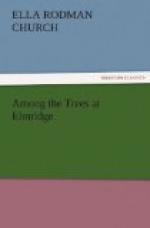“And the deadly upas,” said Malcolm, “is not deadly, after all! I think I shall remember that.”
“And I too,” said Clara and Edith, who had listened with great interest to the description.
“Shall we have some figs now, by way of variety?” was a question that caused three pairs of eyes to turn rather expectantly on the speaker; for figs were very popular with the small people of Elmridge.
[Illustration: THE BANYAN TREE.]
“Not in the way of refreshments, just at present,” continued their governess, “but only as belonging to the mulberry family; and we will begin with that curious tree the banyan, or Indian fig. This stately and beautiful tree is found on the banks of the river Ganges and in many parts of India, and is a tree much valued and venerated by the Hindu. He plants it near the temple of his idol; and if the village in which he resides does not possess any such edifice, he uses the banyan for a temple and places the idol beneath it. Here, every morning and evening, he performs the rites of his heathen worship. And, more than this, he considers the tree, with its out-stretched and far-sheltering arms, an emblem of the creator of all things.”
“Is that only one tree?” asked Malcolm as Miss Harson displayed a picture that was more like a small grove. “Why, it looks like two or three trees together.”
“Does it grow up from the ground or down from the air?” asked Clara. “Just look at these queer branches with one end fast to the tree and the other end fast to the ground!”
Edith thought that the branches which had not reached the ground looked like snakes, but, for all that, it was certainly a grand tree.
“The peculiar growth of the banyan,” continued Miss Harson, “renders it an object of beauty and produces those column-like stems that cause it to become a grove in itself. It may be said to grow, not from the seed, but from the branches. They spread out horizontally, and each branch sends out a number of rootlets that at first hang from it like slender cords and wave about in the wind.—Those are your ‘snakes,’ Edith.—But by degrees they reach the ground and root themselves into it; then the cord tightens and thickens and becomes a stem, acting like a prop to the widespreading branch of the parent plant. Indeed, column on column is added in this manner, the books tell us, so long as the mother-tree can support its numerous progeny.”
“How very strange!” said Clara. “The mulberry seems to have some very funny relations.”
“Such a great tree ought to bear very large figs,” added Malcolm.
“On the contrary,” replied his governess, “it bears uncommonly small ones—no larger than a hazel-nut, and of a red color. They are not considered eatable by the natives, but birds and animals feed upon them, and in the leafy bower of the banyan are found the peacock, the monkey and the squirrel. Here, too, are a myriad of pigeons as green as the leaf and with eyes and feet of a brilliant red. They are so like the foliage in color that they can be seen only by the practiced eye of the hunter, and even he would fail to detect them were it not for their restless movements. As they flutter about from branch to branch they are apt to fall victims to his skill in shooting his arrows.”




